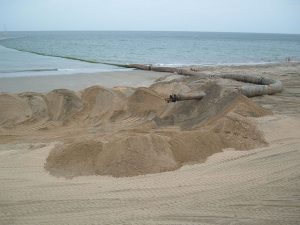The Folly of Beach Restoration

Melbourne Beach, FL — Beach erosion during Hurricane Irene. (Photo by Ty Harrington/ FEMA News Photo)
Beach erosion is reaching disaster levels all over the world. To save those premium property values, beach restoration has exploded into an industry costing hundreds of millions of dollars annually (photo at right). In some locations it is almost a perpetual operation. It brings to mind, Sisyphus – the well known Greek myth about pushing a boulder uphill just to have it roll down, in a forever cycle.
The worsening beach erosion is often blamed on rising sea level with some truth, but that hides the underlying problem. Beach erosion would be happening even without rising sea level — though rising sea level will surely make the problem worse.
What’s the problem?
Beaches have always moved, or migrated. Coastal geologists can track historical beach and shoreline movements, even before human impact. Over a few centuries, shorelines can move greatly, hundreds of feet in either direction. Barrier islands can be created as well as disappear. Let’s look at a few very simple forms of beach erosion.
- Strong coastal storms, like hurricanes, can do major re-sculpting of a beach in hours.
- At the other extreme, along most beaches, there is a slow, inexorable movement of sand along the shore, moving sand down the beach. You can usually observe this, just by looking carefully where the ocean meets the beach, even with the smallest waves. This natural process takes sand from one area, depositing it elsewhere — depletion and accretion.
- Humans introduce a major new effect, wherever we interrupt that natural movement of sand along the shore. Any rock jetty, such as at a marina entrance, stops the longshore movement of sand. Sand piles up widening the beach on one side, and on the other, the beach erodes dramatically.
It is only in recent times that we have built closer and closer to the sea, assuming that “insurance would cover our assets.” In olden times it was understood to be risky and dangerous so no one built that close to the sea. To add to the problem, in the last half-century, our structures became larger, more permanent, and expensive. Think of all the expensive condominiums that seem to have sprung up like sea oats, along gorgeous beaches all over the world
We got caught in a vicious cycle. To make these “condos” worth premium values, they were built as close to the beach as possible. The impression was that the idyllic beach scene was as permanent as the concrete in the building. The developer sells out within a few years and leaves the long-term risk with the buyers. Over a few decades, the beach erodes, particularly during any unlucky storm, but in fact, even without a storm.
The problem in the U.S. can be seen from Florida, up to Cape Cod; all along the Gulf Coast, and in many places along the Pacific. Internationally the problem abounds as well, from Australia to Thailand, even to the Netherlands. The Dutch are some of the world’s coastal engineering experts. Yet they are not immune to the naivete and hubris of acting as if beaches will stay where we want them.
A few years ago, on a working trip to the Netherlands, they proudly showed me a system they called “sand motor” which is a clever way to redistribute the sand to restore a long area of beach. With the right coastal configuration, it can make the process a bit more economical. Yet the engineers soberly told me that the global explosion of beach restoration, would soon “hit the wall” or in fact, run out of sand.
Supplying sand for these global beach restorations is requiring the hauling of sand from greater distances, at ever greater cost. It is the economic law of supply and demand. One expert there told me he thought this fantasy of putting beaches where we want them, would run out of steam within a few decades, perhaps 30 years as it would simply be cost prohibitive.
We have not learned the lessons of coastal erosion and vulnerability yet. In fact, if anything the urgency to stop coastal erosion is stronger than ever. Developers, homeowners, and cities all push the political levers to ensure that their beach gets restored.
Builders, architects, zoning officials, property owners, and the financial community need to see the forces at work with long-term beach erosion and the folly of short-term thinking.
In effect our battle to keep beaches precisely where we want them, is a battle with the sea itself. I know what side I would take if we were making bets on who wins this battle.

